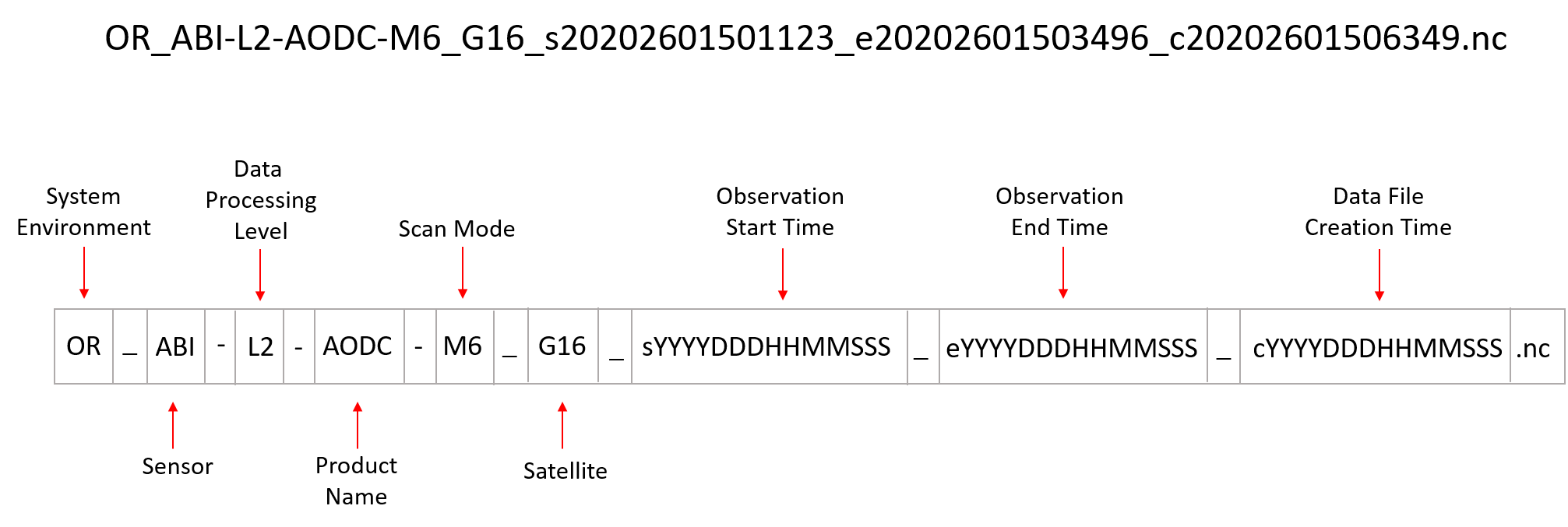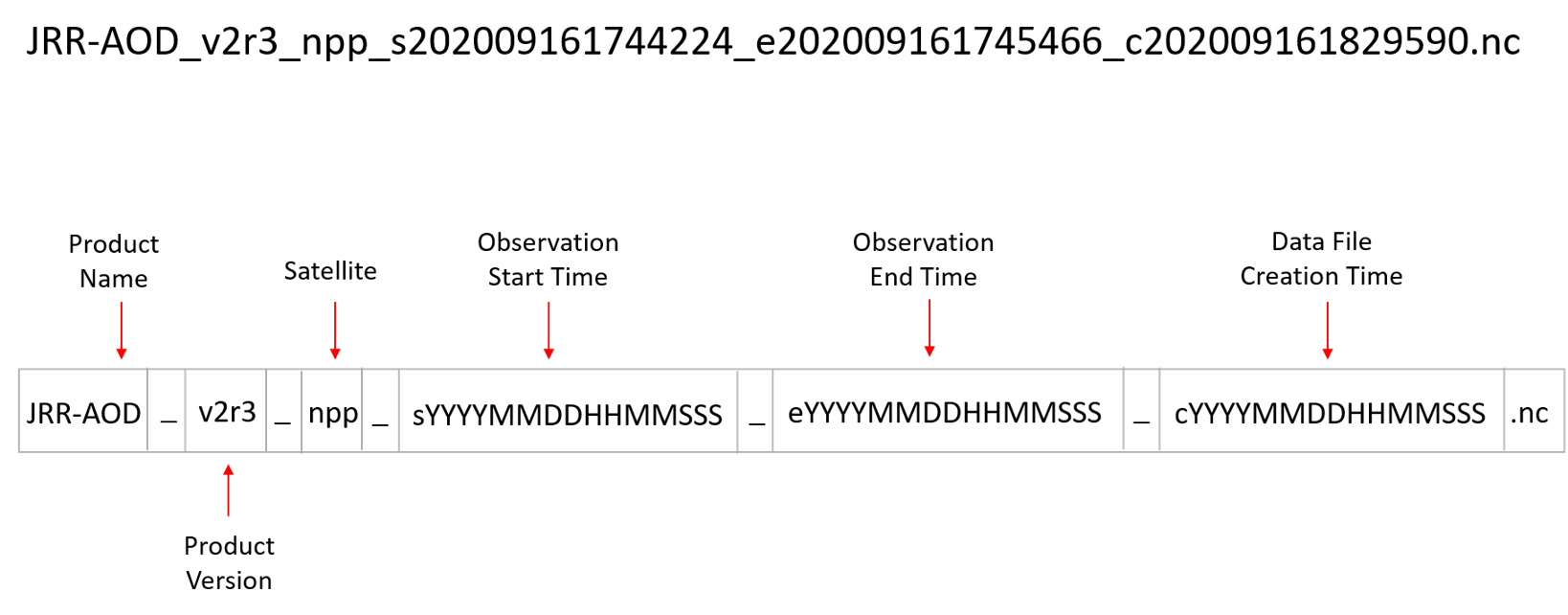Decoding Satellite Data File Names
Satellite data file names are very long, but they follow consistent patterns, as described in the sections below. It is helpful to know how to decode satellite file names, because without even opening a file, you can discern key information from the file name - such as the satellite, sensor, product, and observation date and time.
Decoding ABI Level 2 Data File Names
An example of an Advanced Baseline Imager (ABI) Level 2 (L2) data file name is given below, with a breakdown of each section of the file name (click file name schematic to open full size version).

- System Environment: Operational system using Real-time data (OR)
- Sensor: Advanced Baseline Imager (ABI)
- Data Processing Level: Level 2 (L2)
- Product Name: 3-4 letter abbreviation for the L2 product, followed by 1-letter abbreviation for the ABI scan sector
- Abbreviations for ABI products used in our trainings:
- AOD (Aerosol Optical Depth)
- ADP (Aerosol Detection Product)
- FDC (Fire/Hot Spot Characterization)
- Abbreviations for ABI scan sectors:
- F (Full Disk sector)
- C (CONUS sector)
- M1 (Mesoscale 1 sector)
- M2 (Mesoscale 2 sector)
- Not all L2 products are available for all scan sectors! For example, AOD is not generated for the Mesoscale sectors.
- Scan Mode: Mode 6 (M6), Mode 3 (M3), Mode 3G (M3G), or Mode 4 (M4)
- Satellite: GOES-16 (G16), GOES-17 (G17), or GOES-18 (G18)
- Format for observation start/end & file creation times:
- YYYY (4-digit year)
- DDD (3-digit Julian day)
- HHMM (4-digit hour/minutes in UTC)
- SSS (3-digit seconds to tenth of a second)
- The ".nc" extension indicates a Network Common Data Format version 4 (netCDF4) file
Decoding VIIRS Level 2 Granule File Names
An example of a Visible Infrared Imaging Radiometer Suite (VIIRS) Level 2 (L2) granule file is given below, with a breakdown of each section of the file name (click file name schematic to open full size version).

- Product Name: abbreviation for the L2 product
- Abbreviations for VIIRS products used in our trainings:
- JRR-AOD (Aerosol Optical Depth)
- JRR-ADP (Aerosol Detection Product)
- AF-Iband (Active Fires I-band)
- Product Version: version (v) and revision (r) numbers; used to keep track of product updates
- Satellite: SNPP (npp) or NOAA-20 (j01)
- Format for observation start/end & file creation times:
- YYYY (4-digit year)
- MMDD (2-digit month & 2-digit day)
- HHMM (4-digit hour/minutes in UTC)
- SSS (3-digit seconds to tenth of a second)
- The ".nc" extension indicates a Network Common Data Format version 4 (netCDF4) file
Decoding TROPOMI Level 2 Data File Names
An example of a Tropospheric Monitoring Instrument (TROPOMI) Level 2 (L2) data file is given below, with a breakdown of each section of the file name (click file name schematic to open full size version).

- Satellite: Sentinel 5-Precursor (S5P)
- Data Processing Stream: latency of TROPOMI data product:
- Near real-time (NRTI) (available within 3 hours after observation)
- Offline (OFFL) (available ~24 hours after observation)
- Reprocessing (RPRO)
- Data Processing Level: Level 2 (L2)
- Product Name: abbreviation for the L2 product
- Abbreviations for TROPOMI products used in our trainings:
- AER_AI (UV Aerosol Index)
- AER_LH (Aerosol Layer Height)
- CO____ (Total Column Carbon Monoxide)
- HCHO__ (Total Column Formaldehyde)
- NO2___ (Tropospheric Column Nitrogen Dioxide)
- SO2___ (Total Column Sulfur Dioxide)
- Orbit Number: 5-digit satellite orbit number
- Collection Number: 2-digit data collection number
- Processor Version Number: used to keep track of product updates
- MM (2-digit major version number)
- mm (2-digit minor version number)
- pp (2-digit patch level)
- Format for observation start/end & file processing times:
- YYYY (4-digit year)
- MMDD (2-digit month & 2-digit day)
- T (fixed character, stands for "Time")
- HHMM (4-digit hour/minutes in UTC)
- SS (2-digit seconds)
- The ".nc" extension indicates a Network Common Data Format version 4 (netCDF4) file
Decoding TEMPO Level 2 Granule File Names
An example of a Tropospheric Emissions: Monitoring of Pollution (TEMPO) Level 2 (L2) granule file is given below, with a breakdown of each section of the file name (click file name schematic to open full size version).

- Sensor: Tropospheric Emissions: Monitoring of Pollution (TEMPO)
- Product Name: abbreviation for the L2 product
- Abbreviations for TEMPO products used in our trainings:
- ADP (Aerosol Detection Product)
- AODALH (Aerosol Optical Depth & Aerosol Layer Height)
- HCHO (Formaldehyde)
- NO2 (Nitrogen Dioxide)
- Data Processing Level: Level 2 (L2)
- Product Version: used to keep track of product updates
- Format for observation start date/time:
- YYYY (4-digit year)
- MMDD (2-digit month & 2-digit day)
- T (fixed character, stands for "Time")
- HHMMSS (6-digit hour/minutes/seconds in UTC)
- Z (fixed character, stand for "Zulu")
- Format for TEMPO Scan & Granule identifiers:
- 3-digit Scan ("S") numer
- 2-digit Granule ("G") number
- The ".nc" extension indicates a Network Common Data Format version 4 (netCDF4) file

